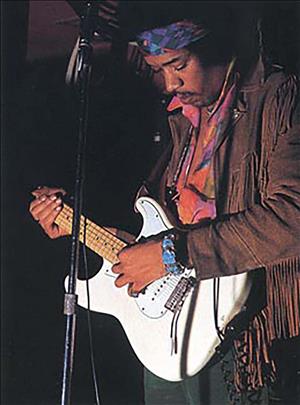On October 1, 1970, rock legend Jimi Hendrix (1942-1970) is mourned at his Seattle funeral and wake and buried in Renton. Hendrix had died on September 18, 1970, at age 27 while asleep in London, not of an overdose as was often reported, but by choking on his vomit while under the influence of barbiturates and alcohol.
A Private Funeral
Funeral services began at 1 p.m. at the Dunlop Baptist Church at 8445 Rainier Avenue S in Seattle. The Hendrix family had requested a private funeral for friends and family only. Media and fans showed up, but respectfully stayed behind rope barriers. The Seattle police were there in case of trouble with crowd control, but the crowd remained orderly.
The Reverend Harold Blackburn officiated. A close family friend of the Hendrixes, Patronella Wright, sang spirituals, and Freddie Maye Gautier delivered the eulogy, reading the words to Jimi's song, "Angel." Dave Anderson, James Thomas, Steve Phillips, Eddy Howard, Donny Howell, and Herbert Price were pallbearers. They were childhood friends of Jimi's, with the exception of Herbert Price, who was Jimi's chauffeur and valet from Hawaii, where Hendrix had been filming that summer.
Jimi's dad Al, and his stepmother June, were there, as were Jimi's brother, Leon, and his sister, Janie. Jimi's grandmother Nora came from Vancouver with her boyfriend Doug. Frank Hendrix, Al's brother, and Al's sister in-law Delores (sister of Lucille, Jimi's mother), and her kids Roberta, Dee-Dee, and Julia attended.
The Experience's bass player, Noel Redding, and drummer, Mitch Mitchell, came. Michael Jeffery, Jimi's manager, made all the preparations and had a guitar made out of flowers for the burial service. The great trumpeter Miles Davis attended, as did Seattle Mayor Wes Uhlman. Other attendees were: Eddie Kramer, chief engineer at Electric Ladyland Studios; roadies Eric Barrett and Gerry Stickells; blues singer Johnny Winter and his manager, Steve Paul, who was owner of the New York club, The Scene, that Jimi frequented; New York music writer, Al Aronowitz; Abe Jacob, who had done the sound for two of Jimi's tours; Chuck Wein, who filmed the movie Rainbow Bridge in Hawaii; Tom Hulett, one of Jimi's closest friends in Seattle, and who had promoted Jimi's Seattle and West Coast gigs; John Hammond Jr., and Buddy Miles.
Eric Burdon, ex-lead singer of the Animals, and a good friend of Jimi's, didn't attend the funeral. He stated that Hendrix hated Seattle, and he thought it was improper to bury him there.
Hendrix was laid to rest in Greenwood Cemetery at 350 Monroe Avenue NE in Renton. His mother Lucille (ca. 1925-1958) is buried there, as is his father, James Allen Ross "Al" Hendrix (1919-2002), his grandmother Zenora Hendrix (1884-1985), and his uncle Frank Hendrix (1918-1986).
After a chorus of "When the Saints Go Marching in," Jimi's casket was lowered into the grave. His gravestone reads: "Forever in our hearts, James M. 'Jimi' Hendrix, 1942-1970."
A private post-funeral gathering was held at the Food Circus (the Center House) at Seattle Center, where Johnny Winter, Miles Davis, and Mitch, Noel, and Buddy Miles played music. The program director from KOL-FM radio station, invited by Tom Hulett, called to say he was going to be late because he was at the "food circus" with the Hendrix family. This went out over the air and fans began to come down to the Center. Hulett spent a good deal of the day explaining that the family wanted to keep the gathering private. The fans cooperated.

